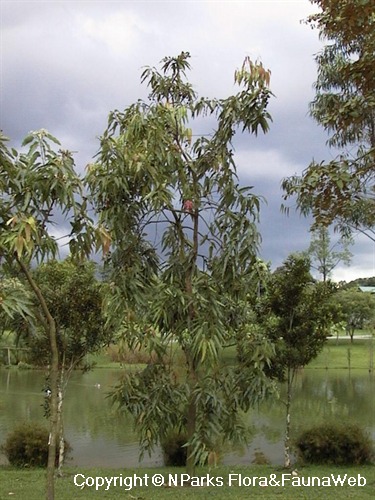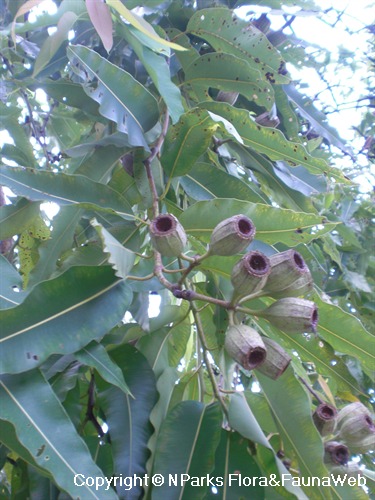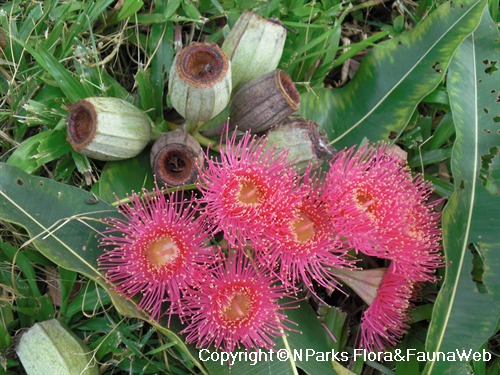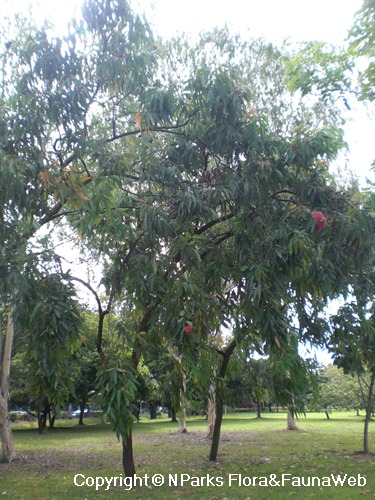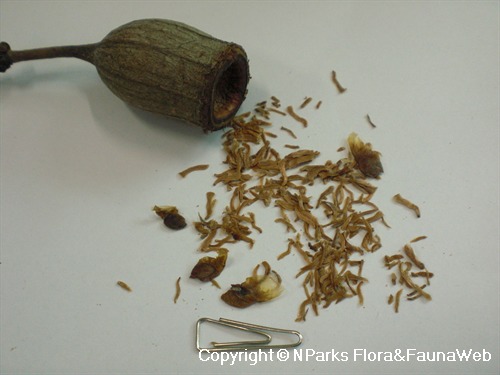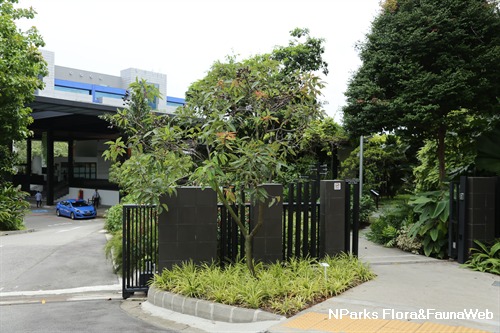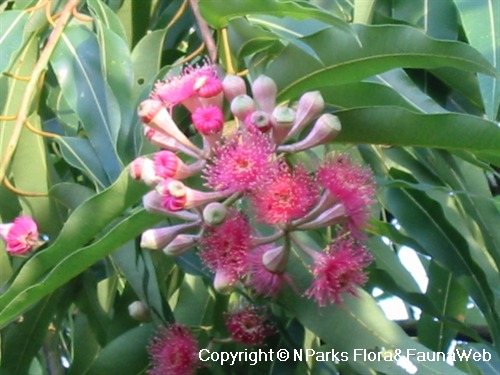
Back
Corymbia ptychocarpa (F. Muell.) K. D. Hill & L. A. S. Johnson
| Family Name: | Myrtaceae |
| Synonyms: | Eucalyptus ptychocarpa |
| Common Name: | Spring Bloodwood, Swamp Bloodwood |
Name
Classifications and Characteristics
| Plant Division | Angiosperms (Flowering Seed Plants) (Dicotyledon) |
|---|---|
| Plant Growth Form | Tree (Medium (16m-30m), Small (6m-15m)) |
| Lifespan (in Singapore) | Perennial |
| Mode of Nutrition | Autotrophic |
| Plant Shape | Weeping / Pendulous, Open |
| Maximum Height | 7 m to 20 m |
Biogeography
| Native Distribution | Australia (Northern Territory, Queensland, Western Australia) |
|---|---|
| Native Habitat | Terrestrial (Secondary Rainforest, Riverine) |
| Preferred Climate Zone | Tropical |
Description and Ethnobotany
| Others - Plant Morphology | Small to medium sized tree, up to 20m height under ideal conditions, native to open forests along streams, rivers and other moist places. Crown drooping, with pendulous branching, especially when young. Trunk reddish to greyish brown, deeply ridged.Leaves semi-glossy green, leathery, fairly large (up to 30cm by 7cm), with pale yellow midrib. Flowers deep pink, less commonly red or creamy white, powerpuff with numerous filamentous stamens, produced in umbels of 3-7 flowers, attract birds. Fruits are cylindrical, explosive woody capsules ("gum nuts"), large (4cm by 3cm). Seeds small, with lightweight chaff to aid wind dispersal.Suitable as roadside tree for showy flowers and attractive foliage. Ideal as waterside tree, due to open weeping form and tolerance of waterlogged soils. Major blooming period in native habitat is late summer to autumn, plant flowers quite freely in local climate.Previously classified as a Eucalyptus, before the bloodwood eucalypts were genetically separated from the former genus in 1995. Genus epithet 'Corymbia' derived from 'korymbos' (Greek for "cluster"), referring to how the flowers are borne in a corymb. Species epithet 'ptychocarpa' means "folded fruit". |
|---|---|
| Ethnobotanical Uses | Others: Flowers and dried fruits popularly used in floral arrangements. |
Landscaping Features
| Desirable Plant Features | Ornamental Flowers, Ornamental Foliage, Ornamental Fruits |
|---|---|
| Landscape Uses | Suitable for Roadsides, General |
| Thematic Landscaping | Water Garden, Naturalistic Garden |
| Plant & Rootzone Preference or Tolerance Remarks | Prefers pH 5.5 -6.4 |
Fauna, Pollination and Dispersal
| Fauna Pollination Dispersal Associated Fauna | Bird-Attracting |
|---|---|
| Pollination Method(s) | Biotic (Fauna) (Vertebrates (Bird)) |
| Seed or Spore Dispersal | Abiotic (Explosive Dehiscence) |
Plant Care and Propagation
| Light Preference | Full Sun |
|---|---|
| Water Preference | Moderate Water, Lots of Water |
| Plant Growth Rate | Moderate |
| Rootzone Tolerance | Fertile Loamy Soils, Well-Drained Soils, Waterlogged Soils (Drains Site) |
| Maintenance Requirements | Moderate |
| Fertilizing | Not required. |
| Propagation Method | Seed |
| Propagule Establishment Remarks | Seeds germinate easily. |
Foliar
| Foliage Retention | Evergreen |
|---|---|
| Mature Foliage Colour(s) | Green |
| Mature Foliage Texture(s) | Glossy / Shiny, Leathery |
| Foliar Type | Simple / Unifoliate |
| Foliar Arrangement Along Stem | Opposite |
| Foliar Shape(s) | Non-Palm Foliage (Lanceolate) |
| Foliar Venation | Pinnate / Net |
| Foliar Margin | Entire |
| Foliar Apex - Tip | Acute, Acuminate |
| Foliar Base | Rounded / Obtuse |
| Typical Foliar Area | Macrophyll ( 182.25cm2 - 1640.25 cm2 ) |
| Leaf Area Index (LAI) for Green Plot Ratio | 3.0 (Tree - Intermediate Canopy) |
Non - Foliar and Storage
| Trunk Type (Non Palm) | Woody |
|---|---|
| Bark Colour(s) | Reddish-brown to greyish-brown |
| Mature Bark Texture | Fissured |
| Stem Type & Modification | Woody |
| Root Type | Underground (Tap Root, Fibrous Root) |
Floral (Angiosperm)
| Flower & Plant Sexuality | Bisexual Flowers |
| Flower Colour(s) | Pink, Red |
|---|---|
| Flower Symmetry | Radial |
| Inflorescence Type | Umbel |
| Flowering Habit | Polycarpic |
Fruit, Seed and Spore
| Mature Fruit Colour(s) | Brown |
|---|---|
| Fruit Classification | Simple Fruit |
| Fruit Type | Dehiscent Dry Fruit , Capsule |
Image Repository
Others
| Master ID | 1594 |
|---|---|
| Species ID | 2887 |
| Flora Disclaimer | The information in this website has been compiled from reliable sources, such as reference works on medicinal plants. It is not a substitute for medical advice or treatment and NParks does not purport to provide any medical advice. Readers should always consult his/her physician before using or consuming a plant for medicinal purposes. |

